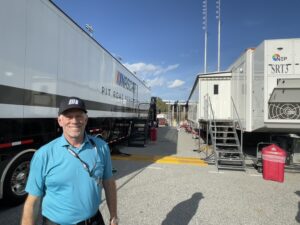Live From Daytona 500: NASCAR Productions’ Steve Stum Provides Update on Planned Facility, Ponders Future of the Sport’s Broadcast Ops
The VP, Operations and Technical Production, is working his 40th Daytona 500
Story Highlights
After 75 years of high-speed racing, close finishes, and legendary stories, NASCAR is working toward creating more memories over the next 7½ decades. For NASCAR Productions, the 2023 Daytona 500 will represent the first race in which every driver on the track will have an in-car camera, but the next priority on its list is making each broadcast more efficient and effective. SVG sat down with VP, Operations and Technical Production, Steve Stum to discuss updates and progress on the 58,000-sq.-ft. centralized production facility scheduled to open in Concord, NC, next year, reflect on his time at the Daytona 500 and NASCAR, and how operations may evolve in the future.

NASCAR Productions’ Steve Stum: “In the next 75 years, there could be an electric series of NASCAR. I spend a lot of time thinking about the future.”
Can you provide an update on the broadcast facility that’s scheduled to open next year?
A lot of our focus is on this building that’ll be north of Charlotte. We had all the outside walls up before the end of last year, and, this week, all of the interior walls are up with sheet rock being planned to be in our broadcast-equipment room by next week. Once that’s finished, NEP Group will begin installing all of our racks with equipment by the middle of March. It has been a very aggressive timeline.
Outside of the facility, we’ve been working with AT&T Global Video Services [GVS] to install 100G circuits at all our tracks across the country. That will give us the ability to do a lot more with sending video back and forth between the track and the facility. By this fall, we’re going to start testing our 1080p workflow in order to move into this new space with that [technology]. This is an outdoor sport, so we’ll get a lot of pop out of 1080p, but we’re continuing through everything that comes with adopting it.
How are you focusing on your week-to-week responsibilities during the season and the construction of this building simultaneously?
I have some really hardworking colleagues and can distribute some responsibilities. They can run operations in the field, and I don’t come out [to the track] every weekend. I’ll come out when we’re doing testing and exploring opportunities for other things that we’ll [eventually want to] connect to the building. Pushing some of the work onto the staff that I surround myself with allows me to manage the day-to-day activities, the operations going on back in North Carolina, and the next steps of the build.
How will your operations plan change with this new centralized production hub?
I think we’re going to have a mix of [onsite and offsite] personnel. The way I’m seeing this GVS network work out is what Fox Sports is doing now. Most of their crew is onsite, but they also have a couple of people at The Vault in Los Angeles and some at NEP’s facility in Pittsburgh. The real question is whether or not we can get to that centralized-production model, where we’ll have staffers at the track but also others in Charlotte or wherever they’re remotely working from. There are a lot of dependencies on the 100G networks to move things around, and, with 1080p, files are going to be a lot bigger. It’s going to be an interesting year to test all of these elements behind the scenes.
What are your overall thoughts on NASCAR’s 75th-anniversary season?
We have a lot of momentum around this celebration. Our ratings and viewership have been on the upswing during the last couple of years, so everyone at NASCAR is extremely excited heading into this season.
There are a handful of highlights on the production and operations side. We’ll be performing a huge mixed-reality presentation with The Famous Group during the prerace. We’ll be using enhanced optical tracking with SMT for the second year in a row, and they also helped us develop new in-venue elements with real-time data on the videoboard.
On the business side, broadcast negotiations began about a week or so ago, and those will be ongoing throughout the year.
How much has the production of the Daytona 500 evolved since your first in 1984?
In the past, we’d show up in one production truck, we would have a couple of in-car cameras, and a total of 8-10 cameras would be considered a big show. It has slowly gone from 40 cameras to 50 cameras, and, today, we’re closer to 70 cameras and have almost 100 lenses total for our in-car cameras. We also have another 20-30 cameras for officiating, and we’re looking into new remote officiating. We’re handling so much more data that has gradually increased over the years. We’re working with all new systems to compile, manage, and filter this information and figure out how to take it to the next step.
After 75 years of NASCAR, where do you think the sport goes moving forward?
There are a handful of projects that I could work on over the next 5-10 years. Are we working with 8K or 16K cameras? Do all of our technologies go fully virtual? I have kids at home in their early 20s, and we play videogames in virtual-reality games, so I ask myself even more questions. Can you put fans into cars? Can you have fans race against the drivers virtually? There’s a lot to mixed reality and how it merges the virtual world with the real world.
When you think back 75 years ago, we were racing on the beach in the sand. In the next 75 years, there could be an electric series of NASCAR. I spend a lot of time thinking about the future.
